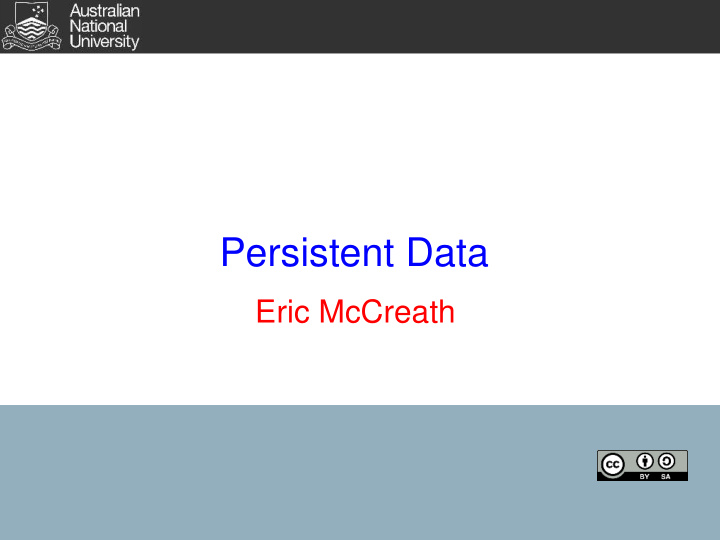



Persistent Data Eric McCreath
Overview In this lecture we will: Consider different approaches for storing a programs information. using Serializable, Bespoke text formats, XML, JSON, and consider the option of using a database. 2
Ways of storing data There are many ways in which your program can store information. These range in complexity from a simple text file to making use of a database like mysql . As you select the approach for your program you should consider what the important factors are in your context. Factors include: required libraries, standard formats, storage effiency/transaction latency, program enviroment configuration, type of data to store, concurrency issues such as atomicity, durability, robustness of the format, and extensibility of the format. 3
Serializable Java enables you to mark a class as "Serializable". And then to save objects of this class you can use an ObjectOutputStream along with the writeObject method to turn the fields of the object into a blob of binary data. By using ObjectInputStream along with readObject you can load the blob of binary data and recover the object with the fields holding their previous values. If we stored an object which held the name and age of a person, in this case Hugh age 10, then Java would store a file like: $ od -c data.ser 0000000 254 355 \0 005 s r \0 027 P e r s i s t D 0000020 a t a S e r i a l i z a b l e 8 0000040 264 261 003 345 360 < 303 002 \0 002 I \0 003 a g e 0000060 L \0 004 n a m e t \0 022 L j a v a / 0000100 l a n g / S t r i n g ; x p \0 \0 0000120 \0 \n t \0 004 H u g h 0000131 4
Serializable Advantages include: very simple to implement, space efficient in storing objects, robust, and fast. Disadvantages include: it is not a standard format that will generally work with other languages, and it is fragile to changes in the fields of the classes you store (if you change your class you may no longer be able load all your old data). 5
Bespoke You may also just come up with your own bespoke format. To do this you simply write a generator and parser for this format and use standard file IO to read and write the file. The format could either be binary or text based. Using a binary approach generally would produce more space efficient storage, although, it would be more involved. Great care is needed to make such approaches robust. Generally this will involve escaping characters. Also the formats can be less amenable to change and extension than approaches like XML and JSON. Comma separated values (CSV) are a defato standard for storing tabular data using a "comma" (or in DSV another token such as ":", ";", or tab) to divide the colmuns in the table. It is often used for transferring data between applications (particularly spreadsheets). 6
Bespoke So a simple approach for storing a persons name and age may be to just use a single line with a colon separating the name and age. So in our example we would store: Hugh:10 Note the above would work fine until Hugh changes his name to "Hugh:21" and starts to apply for a drivers licence! 7
XML Extensible Markup Language (XML) is a standard approach for storing information in a file. The information is stored in textual form and is both human and machine readable. It is widely used and many libraries available. This makes documents in XML very portable. XML uses "tags" to describe "elements" of data. Within the XML document, elements can be nested forming a tree like structure. Below is an example of an XML document that stores a person's name and age. <?xml version="1.0"?> <person> <name>Hugh</name> <age>10</age> </person> 8
XML The standard JDK comes with libraries that enable you to read and write XML documents. The simplest way of doing this is to use the DOM interface. This will parse the entire XLM document into a tree structure which you can traverse and obtain the desired information from. In situations that involve very big XML documents you can use the SAX interface. This does not store the entire document tree, rather, it calls a method that is provided to it. 9
JSON Java Script Object Notation (JSON), like XML, is also an open standard format that is widely used. It was designed to send data between a web client and a server, however, the format has been embraced for more general storage of data. The primary focus of JSON is storing attribute-value pairs and will generally produce smaller and more readable documents than XML. So the name and age of a person could be stored in JSON as: {"age":10,"name":"Hugh"} There is no inbuilt Java library for JSON, however, there are a number of open-source libraries available (our lab machines have json-simple.jar installed). 10
Database If the data you wish to store is accessible by multiple users or multiple instances of the same application then it may be worth storing the information in a database. This could be done using: a light weight approach like SQLite which stores data in a local single file without creating or connecting to a server process. a client-server approach whereby your Java program connects to a database such as MySQL or postgres . Java has a standard API for doing this (the JDBC API). 11
Example Exam Questions What are some advantages in storing information in either XML and JSON compared to sorting information using the Serializable approach? List some differences and similarities between XML and JSON. Modify the code PersistDataXML.java such that it can load and save a list of people rather than just a single person as it currently does. The code is available at: git@gitlab.cecs.anu.edu.au:comp2100/lecture-example-code.git 12
Recommend
More recommend